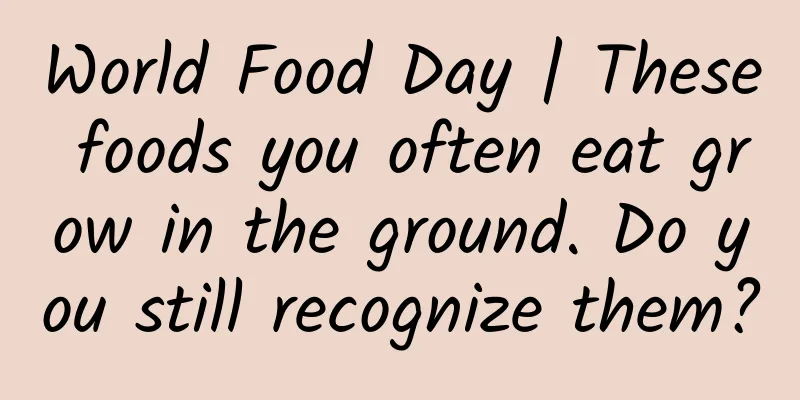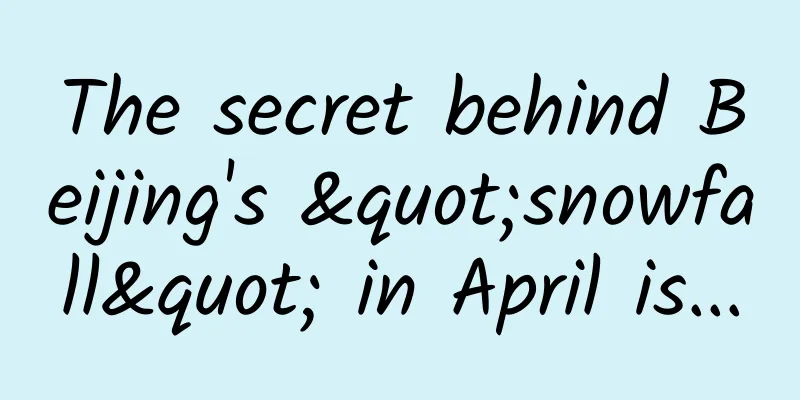World Food Day | These foods you often eat grow in the ground. Do you still recognize them?

|
Today is World Food Day . Let's do a little test: Can you guess what crops these grains (and their dregs) are from? (The answer will be revealed soon) Photographed by the author As the saying goes, food is the most important thing in life. When you enjoy a delicious meal, have you ever wondered what these ingredients look like in the fields? How do farmers grow them? Let's start with food, which is indispensable to each of us. Carbohydrates are one of the six essential nutrients for humans. We cannot do without them to maintain body temperature, physical activity, brain thinking and other life activities. The main source of carbohydrates is generally grains, which are what we call staple foods, including rice, noodles, steamed buns, cakes, bread, porridge, etc., and their raw materials come from several monocotyledonous plants, such as rice, wheat, corn, etc., which will be introduced below. What? The main rice producing area is actually in... Let me first reveal the answer to the question at the beginning of this article. The photo at the beginning is actually all rice (and its processed products). Left, middle and right: rice grains; brown rice and rice husks (husks); polished rice and bran and germ (photo by the author) Why does eating rice have to be so "troublesome"? It turns out that if the stored rice needs to be sold, it needs to go through a series of processing steps, such as cleaning impurities, husking, milling, and finishing finished products. After further cleaning impurities, the husks on the outer surface of the rice grains need to be separated, and the distance between the gears of the machine is adjusted according to the length, fatness and thinness of the rice grains, so that the rice grains can be husked, and then the husks are blown away by the blower, and finally the denser brown rice is collected. Brown rice includes a series of structures such as pericarp, endosperm, germ and endosperm. After milling, brown rice undergoes a "metamorphosis", from a gray and ugly duckling to a white and fat swan, and the taste changes from "scratching the throat" to soft and smooth. It seems that the so-called "every grain of rice is hard-earned" not only refers to the planting of rice itself, but also the processing is very hard. However, it is not without cost to turn it into polished rice. The peel, endosperm and germ that are ground down also contain many nutrients. Therefore, we still encourage everyone to try to eat some brown rice. When we talk about rice, we often think of the "land of fish and rice", which must be in the south. After all, rice is the daily staple food of southerners. However, the province with the largest rice planting area in China is not in the south, but in the northernmost part of China - Heilongjiang Province . This may be different from the impression of green rice fields in the water towns of the south of the Yangtze River in everyone's mind. Rice fields during the rice jointing period (photo by the author) Do you know what maimang is used for? Wheat is the crop with the largest planting area and the highest yield in the world, and its contribution to mankind may be far greater than other crops. Wheat accounts for about 40% of China's staple food consumption, and its market share is slightly lower than that of rice. From this perspective, it seems that there are slightly more people eating rice, but in the world, wheat is undoubtedly the world's largest food crop. This may be due to the stronger adaptability of wheat, plus the fact that various pasta can be varied and varied. For example, the staple foods we often eat, such as steamed buns, dumplings, pancakes, bread, noodles, etc., as well as the bread and pizza of foreigners, are enough to prove that wheat can be integrated with various food cultures in the world and has strong plasticity. There is a saying that goes "a needle against a wheat awn". Wheat awn is a signature feature of wheat. In fact, some rice also has rice awns, but they have gradually disappeared after modern breeding. So what is the function of wheat awns? It turns out that it can prevent birds from eating it to a certain extent - it will prick your mouth. Some awns have hooked barbs that can attach to animal hair and take a "ride" to distant places to take root. Wheat is usually planted in autumn. After the frost and snow in winter, it breaks through the ice and grows in spring. It turns green, grows joints, forms ears and blooms, and it continues to grow endlessly, showing the unyielding side of wheat in the face of the powerful force of nature (there is also spring wheat, but I won’t go into details here). Wheat can be ground into wheat flour and separated into wheat germ and wheat bran after harvesting, drying, removing impurities, grinding and screening. Wheat bran has a poor taste and is generally used as animal feed. Wheat germ is rich in nutrients such as vitamin E, vitamin B1, protein, etc. It is the most nutritious part of wheat and is generally sold as a health food. The endosperm part with the highest content is processed into wheat flour used as a raw material for pasta. The current popular healthy diet usually advocates eating whole wheat bread, where whole wheat is wheat flour that contains wheat bran and wheat germ. In the past, large pieces of wheat bran were picked out, and white, soft and delicious bread was expensive, while black bread with bran was cheap. But now the price of whole wheat bread is higher than that of white bread. In today's refined diet, people pay more attention to the nutrition of food rather than just the taste. Do you know how thin the ancestors of corn were? Who is the ancestor of corn? There used to be a lot of controversy about this question, but it is now generally recognized that the origin and evolution of corn are closely related to teosinte. People in southern Mexico planted teosinte 8,700 years ago. At that time, teosinte was very different from the current corn in shape. The ear was probably only a little longer than the diameter of a coin (about 24mm), and the number of seeds was very few, which made people have no motivation to chew it. By 6,200 years ago, teosinte changed from 2 rows of seeds to 4 rows. 2,000-3,000 years ago, the number of corn seeds reached 10 rows; 1,000 years ago, corn finally became almost the same as modern corn, and the size and number of grains were similar to today, which is worth chewing. Teosinte (left) and modern corn (right) images from https://www.nsf.gov/ Speaking of corn, we can immediately think of sweet corn and sticky corn cobs, fried corn kernels, roasted corn, popcorn, etc. Some friends also know that corn is feed for many livestock or a raw material for making starch. In fact, corn is not only edible, but also an important sugar crop and energy crop. Yes, corn is so versatile. The starch in corn kernels is hydrolyzed into small molecular sugars as raw materials to produce corn syrup, which is cheaper than sucrose and widely used in the United States to add sugar to beverages. In addition, corn cobs and corn stalks are processed into livestock feed, thus providing us with abundant meat, eggs and milk. Unlike the rice and wheat we often eat, corn belongs to C4 plants, while rice and wheat belong to C3 plants. Corn's efficiency in using water and sunlight is much higher than that of rice and wheat. At present, corn has become the basic raw material for many industrial products, such as xanthan gum in food, which is used as a food thickener; the United States is also studying the processing of corn into ethanol gasoline for automobiles to resolve the current rising energy prices. In summary, corn may be the most versatile of common food crops. After all, it can be eaten, used, and burned... Maybe humans use these crops to feed themselves, or maybe these crops also use humans to expand their living space. No one knows who uses whom. But we cannot live without them today, and we cannot live without them. We eat a steamed bun, a bowl of noodles, a bowl of rice, and a few dishes today. Maybe we have only seen it in stores, or even in takeout boxes. But can we recognize it at a glance in the fields and understand the unknown stories behind it? Planning and production Author: Zhang Cong, a graduate student in agronomy and seed industry Review丨Cheng Xuzhen, Researcher, Institute of Crop Sciences, Chinese Academy of Agricultural Sciences Planning丨Ding Zong Editor: Ding Zong |
<<: Is a "space funeral" actually possible?
Recommend
Lincang SEO Training: How do website SEO optimization tools help with optimization?
The work of website SEO optimization is not compl...
Heartbeat Journey - iOS uses the phone camera to detect heart rate (PPG)
[Background] Time flies, and in recent years, dev...
World Meteorological Day丨Spanning two centuries, the "super-super-long struggle history" of weather radar
March 23 is the 65th World Meteorological Day. Th...
After reading these brand copywriting, let’s talk about what “copywriting tone” is
The first time I heard the word "tonality&qu...
Do we have to be better ourselves? Perfectionism is not "perfect"...
In daily life, perfectionism is often seen as a p...
Encyclopedia of Cat Family Medicine (Newly Revised Edition)
Introduction to the Encyclopedia of Cat Family Me...
Don't buy this kind of crappy socket!
According to the data from the Ministry of Public ...
The nuclear power plant’s new sideline business – producing pearls!
Nuclear power plants are places where nuclear ene...
Download the full set of "Uncle Kai's Sound and Rhythm Enlightenment" audio and listen online to Baidu Netdisk sharing address
Download the full set of "Uncle Kai's So...
McLaren releases 675LT MSO official pictures, limited to 25 units worldwide
According to foreign media reports on December 9,...
Product and Operation: A pair of good friends who love and hate each other
Today let’s talk about the conflicts with operati...
Why do ducks stand still in the rain when it rains? | Expo Daily
Why when it rains, The duck just stood there in t...
"Fragmented sleep" has become a hot topic, and doctors remind you: sleeping may be the same as not sleeping
How's your sleep? In recent days, there have ...
Android MVP framework learning and practice
Preface I thought that Internet companies basical...









